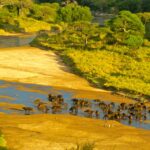Welcome back! readers and travelers. We hope you remember our last blog on Tanzania A-Z, A for Aardvark. One of the least concern species of Earth. Here we are back with another famous African animal the wild Buffalo or “African cape buffalo”.
This animal seems to be quite familiar, isn’t it?
Probably you may have seen buffalos in your surroundings, but don’t assume it to be similar to African Cape buffalo. Because they are much bigger and aggressive than your home cattle.
Cape buffalo is known as one of the members of African Big 5. Moreover, these animals are known as Mafia of the jungle as they are aggressive and furious hunters even can kill the predator like a lion or cheetah.
These animals are more dangerous to humans than any predators if you encounter them openly during Tanzania Safari.
Before visiting them in Tanzania, let’s know few things about them in brief:
Member of African big Five
As we have mentioned that African Cape Buffalo or Syncerus Caffer is one among the African big five.
There are several big species in Africa like the hippo, rhino, cheetah, and crocodile. But among them, Buffalo is ranked in big 5 because of their massive bulky body, aggressive strength and skill power.
Ngorongoro and Serengeti are the two best Tanzania Destinations to spot the cape buffalos.
Body construction

From lips to tail, Cape buffalo lengths 1.7-3.4 meter, whereas from shoulder to toe its height is 100 to 170 meter. They have a huge muscular body with two big horns to defend themselves from predators.
The length of male buffalo’s horn is much bigger than females (males have 4 feet longhorns). Though both males and females seem to be similar.
Adult Cape buffalo weighs from 300 to 900 kg (male 650 to 900kg, female 550 to 80o Kg). Whereas, the newly born calf weighs 50 to 60 Kg. These bossy animals can reach a maximum weight of 1000 Kg.
Their Exceptional Sharp Memory

According to the research, it’s being said that Cape buffaloes are having a weak sighting and hearing power. But these animals are blessed with sharp memory.
If any human or predators cause any trouble to the Cape buffalo then they can remember them even after several years. Their exceptional memory power made them one of the furious revengers on earth.
They have the highest record of human encounter than any predator
The cape buffaloes are of bossy nature, so they don’t like any interference by other species in their area. Moreover, their body is having heat-sensing power and they can smell the presence of others.
They are very sensitive towards their troop members and calves, so never let anyone to walk inside their area.
So, when a predator tries to enter into their place, then Cape buffalo sense them in advance. After that, they make a circle and keep their calves inside it, and get their horns ready in a defending position.
Though thePredators are the furious animals of jungle, cape buffalos have the record of highest human encounter in African Destinations.
Territory & habitat

The buffalos are having their specific territory, where they don’t like snooping of others. Generally, they can be found near the water bodies as they must drink water twice a day.
If a buffalo don’t get proper food and water throughout the day then they can die out of starvation. Theseanimals always stay in the herd while roaming and grazing.
During Tanzania Safari you can encounter them in various national parks. Cape buffalo can also be found in woodlands and rainforest of the African continent.
Social life-style

African Cape Buffalo lives in large herds of 1000 in a single territory, which is again divided into small herds of 12 to 15 members each. Their subgroups are again divided in a ratio of bachelor, mixture, females, and males, old and young ones.
The gestation period of Cape buffalo is for 9 to 11 months. After that, they give birth to a single calve at once. Cape buffalo reproduce new babies during rainy seasons. Up-to 3 years the baby lives with their mother and after that, they mix up with different calves.
A cape buffalo’s life can extend from 15 to 25 years if healthy. Within a day these wild cattle can consume almost 11 Kg of green grass and plants.
All the members of the herds play various roles, here male use to defend and protect others. Whereas the female take care of the younger one and show the direction towards which they will move next.
Eating Habits
Despite being in the list of most aggrieve animal African Cape Buffalosare herbivore in nature. They mostly depend on green savannah, large and small grasslands, and herbs as well as shrubs.
Every single day, each buffalo consumes several Kilograms of green plants. Afemale buffalo consumes a bit more than the male one. Moreover, they use to consume water 1 to 2 times a day.
Some interesting Facts about cape buffalos :
- African Buffaloes are the only cattle that cannot be domesticated.
- They are even seen of doing “voting” before moving to any particular direction which is quite unusual in wildlife.
- Male buffalos have thicker neck skin than females.
- Moreover, the male buffalo is having hums on the shoulder and fringe.
- These buffaloes polish their horns with the trunk of trees to polish it and fill the gaps.
- African Cape Buffalos are having a strong relationship with migrating birds, as they help them to clean their body.
- Birds use to alert the African buffalo before any problem comes towards them.
- The African buffalo can sprint with a speed of 37 miles per hour.
We hope that this information will help you to gain essential knowledge about Cape buffalo. Now, are you feeling curious to explore them? If yes, then the Tanzania National Parks are the best places to encounter them.
So, if ever in your life you get a chance to go for Tanzania Safari then don’t forget to carry your photography tools with you. It is so because this nation is filled with stunning wilderness in its scenic landscapes.
Stay tuned and subscribe Snow Africa Adventures to get the next update on alphabet “C”.
















